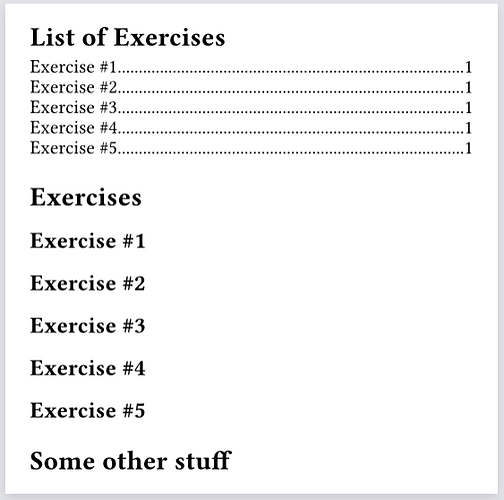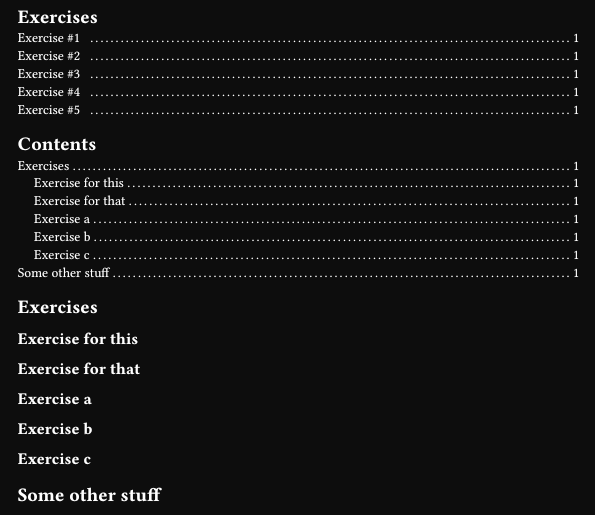Hello, first post in here, hope I didn’t mess up the tags and category.
So I am making revision cards, in which there are exercises that I’d like to review. I labelled the header of each exercise with <exercise:name-of-the-execise> and since I have so many, I would like to make an outline specifically for them. Is there a way to do so, and if not do you have any idea of how to do something similar? Thank you.
This took a bit, but should work well enough for you to customize to your own liking! I’m not sure how much your document might kick the bucket, but here it is anyway.
- First any element, you have referenced with a
exerciselabel should be selected via theselector.or→ here I’ve just limited to heading, but if you have more, just add it there - Get the labels of the elements and insert
noneif it doesn’t have one → we get a list of all elements reduced down to their labels - Then filter for the
exercise:references → inexercisesyou’ll have the desired references - Throw it in a for loop, query the element and start building your outline
- I’ve created a simple list
#set page(height: auto, width: 10cm, margin: 5mm)
#let exercise-outline = context{
let exercises = query(
selector.or(
heading,
/* other referencable elements such as math.equation or figure */
)
).map(x => x.at("label", default: none)).filter(x => (x!= none) and str(x).contains("exercise:"))
heading(level: 1)[List of Exercises]
for rf in exercises {
let element = query(rf)
block(above: 0.4em,grid(columns: (auto, 1fr, auto), element.at(0).body, box(width: 1fr, repeat[.]), link(element.first().location(), [#element.first().location().page()])))
}
}
#exercise-outline
= Exercises
== Exercise \#1 <exercise:1>
== Exercise \#2 <exercise:2>
== Exercise \#3 <exercise:3>
== Exercise \#4 <exercise:4>
== Exercise \#5 <exercise:5>
= Some other stuff <blabla>
When you throw a reference into str(...), you’ll get the reference text itself!
Hey @Ruben, welcome to the forum! I’ve changed your question post’s title to better fit our guidelines: How to post in the Questions category
Make sure your title is a question you’d ask to a friend about Typst. ![]()
I’m guessing the best bet for now is either to recreate outline from scratch (@Electron_Wizard’s example), or wrap the headings in a figure with a custom kind that can be passed as a selector to the outline.target field, which is @PgBiel’s idea:
#set heading(numbering: "1.")
#show heading: it => {
if not it.has("label") { return it }
let label-name = repr(it.label).replace(regex("(^<|>$)"), "")
if not label-name.starts-with("exercise:") { return it }
show figure: set align(left)
figure(it, kind: "exercise", supplement: none)
}
#show outline.entry: it => {
if it.element.func() != figure or it.element.kind != "exercise" { return it }
let h = it.element.body
let numbers = counter(heading).at(h.location())
let prefix = context numbering(h.numbering, ..numbers)
it.indented(prefix)[#h.body #box(width: 1fr, it.fill)#it.page()]
}
#outline(title: "Exercises", target: figure.where(kind: "exercise"))
#outline()
= Exercises
== Exercise for this <exercise:1>
== Exercise for that <exercise:2>
== Exercise a <exercise:3>
== Exercise b <exercise:4>
== Exercise c <exercise:5>
= Some other stuff <blabla>
But I think the perfect outline formatting is gone anyway, unless there is a better way.
Here is one solution that starts similar to the one given by @Electron_Wizard, but uses the actual outline element, which simplifies this a bit and allows show and set rules to still be applied:
#let exercise-outline(title: [List of Exercises]) = context {
// Find all used <exercise:..> labels.
let labels = query(heading)
.filter(it => it.has("label") and str(it.label).starts-with("exercise:"))
.map(it => it.label)
// Create outline targeting headings with those labels.
outline(
indent: 0pt, // (maybe not necessary in your case)
title: title,
target: selector.or(..labels.map(label => heading.where(label: label)))
)
}
#exercise-outline()


